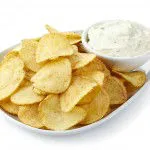
- Share on Facebook106
- Share on Pinterest
- Share on Twitter
Regular snacking has its benefits, often helping to keep blood glucose levels under control as well as keeping you from overeating at your next meal. But selecting those snacks is oh so important.
A recent study published in the Journal of the American Association for the Study of Liver Diseases, Hepatology, demonstrated that a poor snack selection will not only increase your waistline, but also fatten up one of your most important organs, your liver.
In the study, researchers examined whether high-calorie diets consisting of either frequently consumed high-fat and high-sugar snacks or having fewer larger meals affected liver health more.
Lean men were instructed to increase their daily calorie intake either by frequently consuming high-fat and high-sugar snacks between meals or combining them with their daily meals to create a larger portion size. The participants remained on the hypercaloric diet for six weeks.
Not surprisingly, the increased calorie consumption resulted in weight gain in all the participants, yet those who were instructed to snack more frequently experienced increased intrahepatic triglyceride content (IHTG) as well as the accumulation of more dangerous abdominal fat as compared with those who combined their snacks with three daily meals.
These results are significant since high-fat and sugary snacks are in abundance these days and are often marketed to children.
“American children consume up to 27% of calories from high-fat and high-sugar snacks,” said lead author Dr. Mireille Serlie with the Academic Medical Centre Amsterdam in The Netherlands. Increased IHTG is associated with the development of hepatic steatosis, or fatty liver, one of the most prevalent liver diseases in America.
Furthermore, the accumulation of abdominal fat poses its own set of risks. Researchers from the Harvard School of Public health note that abdominal fat in particular is biologically active, secreting its own set of hormones and other compounds that negatively affect our health and increase risk factors for developing colorectal cancer, liver disease, cardiovascular disease and a number of other chronic health conditions.
A 2010 Australian study found that normal weight women who carried a higher percentage of abdominal fat were significantly more insulin-resistant than those who carried more peripheral fat.
Surprisingly, this held true even when the women with more abdominal fat had lower BMIs than the the women with more peripheral fat, attesting to the dangers of even a little mid-section fat.
For those that need frequent meals and snacks throughout the day, be sure to avoid sugary and high-fat choices and instead choose organic fruits and veggies coupled with protein.
 Note: the emphasis should really be on the reduction of high-sugar and high unhealthy fat (eg., trans-fat laden) snacks, since saturated fat is generally very healthy as we have written about elsewhere .
Note: the emphasis should really be on the reduction of high-sugar and high unhealthy fat (eg., trans-fat laden) snacks, since saturated fat is generally very healthy as we have written about elsewhere .
Here are a few options you can try the next time hunger strikes between meals.
- Organic Greek yogurt and fresh fruit
- Sliced organic tomato with olive oil and Feta cheese
- Organic string cheese with grapes
- Organic apples, celery or bananas with nut butter
- Organic baby carrots with hummus
- Organic hard boiled eggs with fresh fruit
-The Alternative Daily
Sources:
http://www.sciencedaily.com/releases/2014/05/140506120036.htm
http://onlinelibrary.wiley.com/doi/10.1002/hep.27149/abstract
http://www.health.harvard.edu/newsweek/Abdominal-fat-and-what-to-do-about-it.htm
http://diabetes.diabetesjournals.org/content/45/5/633.short
http://www.womenshealthmag.com/weight-loss/100-calorie-snacks
- Share on Facebook106
- Share on Pinterest
- Share on Twitter

